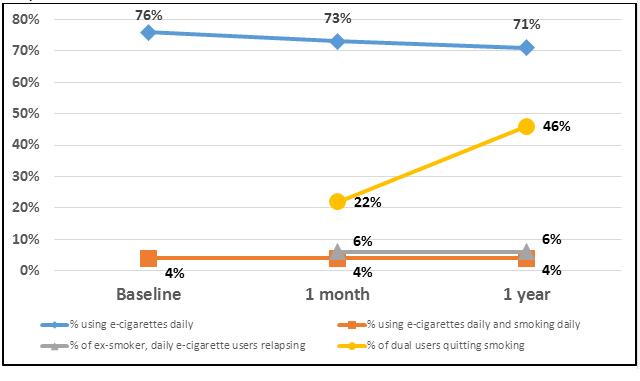Editor’s Note: Today’s ASHES was written by Kerry Brechbiel. Kerry is a special contributor to the BASIS and a graduate student at East Carolina University.
Electronic cigarettes (e-cigarettes) have become a popular alternative to smoking, viewed as a cleaner, safer way to obtain a nicotine fix (Ungar, 2014). Although there is a paucity of scientific research on e-cigarettes, preliminary evidence suggests that their use might reduce cigarette use and increase smoking cessation (Bullen et al., 2013; Caponnetto et al., 2013; see ASHES 7(3) and ASHES 9(13)). This week, the ASHES reviews a longitudinal study of behavior change among e-cigarette users across 12 months (Etter & Bullen, 2014).
Methods
- The researchers posted a questionnaire about smoking and e-cigarette behaviors (in English and French) on the smoking cessation website Stop-Tabac.ch.
- The researchers posted links to the questionnaire on websites that provided information about or sold e-cigarettes, as well as specialized discussion forums.
- A total of 1,329 individuals completed the questionnaire. Of these, 773 provided their e-mail address and opted to participate in a follow-up study.
- Participants completed questionnaires at baseline, one month post-baseline, and one year post-baseline addressing the following topics:
- E-cigarette use
- Current smoking
- Tobacco use in the past 7 days
- Cigarettes per day (for current smokers)
- Quit date (for former smokers)
- 477 individuals (62% of the 773 who provided email addresses) responded to the survey after one month, and 367 (48%) responded after one year.
Results
- Participants who completed at least one follow-up questionnaire were different at baseline than those who dropped out. They were more likely to be daily e-cigarette users, more likely to be former smokers, and more likely to report an intention to quit smoking in the next 6 months than those who dropped out.
- Figure 1 indicates daily e-cigarette use, dual use (i.e., both smoking and using e-cigarettes daily), relapse to smoking, and smoking cessation at one month and one year post-baseline.
- On each occasion, about three quarters of the sample used e-cigarettes daily.
- Among those who were ex-smokers at baseline, later relapse to smoking was rare: 6% had relapsed to smoking cigarettes at the one month follow-up, and 6% had relapsed at one year post-baseline.
- The percentage of dual users remained at 4% from baseline to the one month follow up, and one year post-baseline follow up.
- Among dual users at baseline, 22% quit smoking by the one month follow-up, and 46% quit by the one year post-baseline follow-up.

Figure. Participant e-cigarette-related and tobacco-related behaviors (adapted from Etter & Bullen, 2014). Note. Reported results at baseline were limited to the 477 who completed at least a 1 month follow-up. Sample sizes for baseline and one month post-baseline follow-up are therefore 477; sample size for one year post-baseline follow-up is 367. Click image to enlarge.
Limitations
- Information about use of cigarettes and e-cigarettes was based on self-report, which is susceptible to bias and memory errors.
- Participants were self-selected from a smoking cessation website and other e-cigarette-related websites. Therefore, they are not necessarily representative of all smokers.
- Participants who dropped out of the study differed significantly from those who completed the study on several key variables.
- There were a small number of dual users who participated in the study.
Conclusion
In this study, the majority of daily e-cigarette users remained using throughout the 12 month study, signifying that e-cigarette use might be a chronic behavior for many users. Among the small number of participants who were both smoking and using e-cigarettes at baseline, many stopped smoking. However, this study was not able to establish a causal link between e-cigarette use and smoking behaviors. Future research is needed to replicate these findings for further validation with a larger and more representative sample. Researchers should look into the specifics of how e-cigarette use directly contributes to smoking cessation, including comparing e-cigarette use to other cessation tools. In addition, this study indicates that future research should examine the health consequences associated with the chronic use of e-cigarettes.
–Kerry Brechbiel
References
Adkison, S.E., O’Connor, R.J., Bansal-Travers, M., Hyland, A., Borland, R., Yong, H. H., et al. (2013). Electronic nicotine delivery systems: international tobacco control four-country survey. American Journal of Preventive Medicine, 44, 207-215.
Bullen, C., Howe, C., Laugesen, M., McRobbie, H., Parag, V., Williman, J., et al. (2013). Electronic cigarettes for smoking cessation: a randomized controlled trial. Lancet (Early Online Publication, 9 September 2013), http://dx.doi.org/10.1016/S0140-6737(13)61842-5
Caponnetto, P., Campagna, D., Cibella, F., Morjaria, J.B., Caruso, M., Russo, C., et al. (2013). EffiCiency and Safety of an eLectronic cigAreTte (ECLAT) as tobacco cigarettes substitute: A prospective 12-month randomized control design study. PLoS One, 8, e66317.
Etter, J.-F., & Bullen, C. (2014). A longitudinal study of electronic cigarette users. Addictive Behaviors, 39, 491-494.
Ungar, L. (2014). E-cigarettes’ growing popularity poses danger to kids. USA Today 5 January.
What do you think? Please use the comment link below to provide feedback on this article.





Kandy Foote March 21, 2014
What is the age range of subjects in this study? It is my belief that younger people (teens/young adults) use e-cigarettes for different reasons than someone who has been smoking much longer.